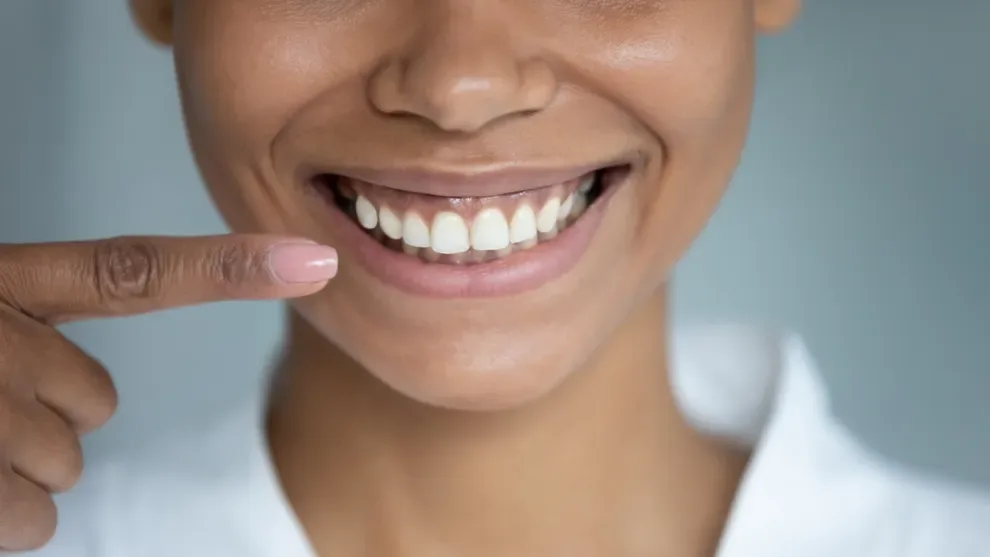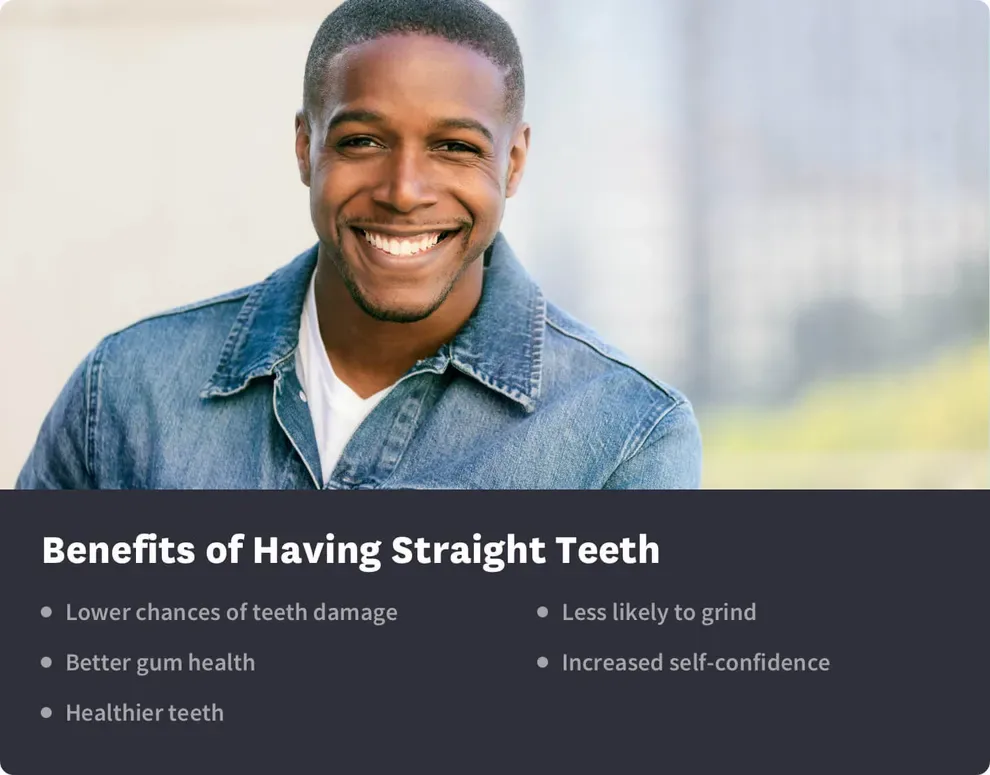What Are 'Perfect' Straight Teeth? (How Can You Get Them)

Table of Contents
- What is a Perfect Smile?
- Causes of Crooked Teeth
- How to Get Perfectly Straight Teeth
- Benefits of Straight Teeth
Close your eyes and imagine the perfect set of pearly whites. What do you see? While we may not be able to define or describe the attributes of an ideal smile, we probably know what makes one set of teeth better than another.
Some people are born with smiles meant to dazzle. But plenty of us have crowded, crooked, or twisted teeth.

What does a perfect smile look like?
"I'll know it when I see it." This is how many of us might describe the perfect smile. But scientists look at things a little differently. In study after study, they have identified attributes that most people find attractive in the smiles of others.
A perfect smile contains:
Symmetrical teeth. Your central incisors should meet in a straight line, experts say. The teeth should mirror one another from that central point.
No harsh angles. Teeth should not jut out or push through the lips. The mouth should easily close.
No gaps. Daylight should not shine between teeth. Every tooth nests close to a neighbor without overlapping.
Small buccal corridor. When you smile, a dark space is visible at the edge of your mouth. That space, researchers say, should be minimal. When it's large, people say the smile is less pleasing.
No visible gums. When your lips part and you smile, the gums should stay safely tucked away and out of view. Too much gum showing is often desired as less desirable.
Flip through magazines, watch videos on your phone, or plop down in a movie theater. Perfect smiles are everywhere. But walk down the street or chat with friends, and perfection is harder to find. Treatments can help, and people spend a lot of money in the quest for a perfect smile.
Braces and aligners are common correcting tools people use to perfect smiles, but there are other options out there that can help, including veneers.
What causes crooked teeth?
No one sets out to make teeth crooked, twisted, or crowded. But our bodies and our habits can work against our smile.
Some causes of crooked teeth are out of our control, including:
Transitions. Adult teeth push through the gums during adolescence. If they hit an obstacle along the way, like an existing baby tooth, they can erupt in an unusual spot.
Genetics. If your parents have crooked teeth, you might share the trait.
Jaw size. Your upper and lower teeth should fit together perfectly. When one set of jaws is too big or too small, the unusual bite pushes teeth out of position.
Some daily habits result in crooked teeth, experts say. If you chew on objects like pens or pencils, thrust your tongue against your teeth, or breathe through your mouth, you can push teeth out of alignment. Many people engage in these habits subconsciously, and over time, the damage they cause can be significant.
The way we eat can also play a part. Researchers examined ancient skulls and found heads full of perfectly straight teeth. But the jaws on those skulls were larger than ours. Experts theorize that ancient people used their teeth as tools, and they often had to push, grasp, and bite things with their teeth, whereas we would reach for hammers, screwdrivers, and nails. We also don't eat tough, uncooked food like our ancestors.
These diet changes led to smaller jaws. And those smaller jaws don't have room for all the teeth we are growing. Lack of space leads to crooked teeth.
How to get perfectly straight teeth.
It may be impossible to completely prevent crooked teeth. But we aren't required to live with them when they appear. We have plenty of tools that lead to straighter smiles.
People with crooked teeth often lean on one of three correction methods.
Metal brackets and wires connect teeth. Over time, the gentle pressure from a tightened wire pushes teeth into new positions.
Braces are painful, and they can be expensive, but they are a good option for people with significant dental issues. They are also very obvious, so many adults aren’t thrilled about the idea of drawing so much attention to their mouths.
Plastic trays cover teeth from roots to tips. Trays are swapped out for new versions every couple weeks, and each tray applies pressure in new ways. In time, teeth take up new positions.
Aligners are often less painful than braces, and they can be significantly less expensive. They can potentially move teeth more quickly than braces, resulting in shorter treatment timelines.
Doctor-monitored, at-home aligners also don’t require any in-person visits with an orthodontist, so the treatment process is very convenient. They are a good choice for people with mild or moderate issues.
Both braces and aligners take time. People without that time or patience can opt for veneers. Porcelain covers each tooth, and veneers look natural to the naked eye.
Your dentist will file down your natural teeth and cover it with porcelain veneers. These veneers can cover gaps between the teeth, and they often look great.
But they are expensive. Veneers can cost up to $2,500 per tooth, researchers say, and they will need to be replaced every 10 to 20 years.
No matter what route you choose, a perfect smile can be well within your grasp. And for plenty of people, that work is well worth doing.
Benefits of having straight teeth.
More adults pursue orthodontics like clear teeth aligners, so they have confidence in their radiant smile. However, there are health benefits to having teeth in proper alignment.
Teeth are easier to clean. Misaligned teeth might have hard-to-reach surfaces, especially on the sides of the teeth. Food can get trapped in these areas, so even if you brush and floss as recommended by the American Dental Association (ADA), you are more likely to develop plaque faster, which can lead to tooth decay, cavities, and gum disease.
Healthier gums: With a higher risk of gingivitis comes a higher risk of thinning or receding gums, tooth decay, tooth loss, heart disease, bone decay including in the jaw, and stroke.
Less strain on the teeth and gums: Even if you keep your teeth clean and gums healthy with a good oral hygiene routine, misaligned teeth do not fit properly, which can create strain on your teeth and jaw. This increases the risk of cracked or chipped teeth, damaged or thinning enamel, inflamed gums, and jaw strain leading to TMJ.
Better oral health: It is normal to develop cavities or gingivitis at some point in your life, but teeth that are in proper alignment are less prone to these issues, provided that good hygiene and regular dentist visits are maintained. This means you are less likely to need root canals, lose teeth, require dental surgery, or even get dentures later in life.
Less jaw grinding: Teeth that do not fit together properly can cause you to clench and grind your teeth, especially while you sleep. This might lead to sleep apnea, a condition that prevents you from getting enough rest, increases cortisol levels, and increases your risk of heart disease.
Fewer headaches: When you have less muscle strain from clenching or grinding your teeth, you are less likely to develop head and neck strain, which can cause headaches, migraines, or even back pain.
Improved, clear speech: When your teeth are out of proper alignment, you are more likely to have a lisp or struggle to form certain words or sounds. This can impact your self-esteem, your work life, and your social life.
Better digestion and weight: When your bite is misaligned, you are more likely to have trouble eating, especially tougher foods with more fiber, crunch, or crispness. This often includes fresh fruits, vegetables, and whole grains, seeds, and nuts — the healthiest foods you can eat. If your teeth hurt from biting into a food, you are more likely to avoid it and eat something softer. This usually means more processed food, which is bad for digestive health.
Lower risk of long-term health problems: The stress, digestive issues, sleep difficulties, and increased risk of infections from misaligned teeth all take a toll on your long-term health. This increases your risk of diabetes, heart disease, heart attack, stroke, pulmonary embolism, and joint pain.
Increased self-confidence: You may worry that there is too much social pressure to have straight teeth, even if your teeth and mouth are otherwise healthy. However, you might also feel embarrassed by a tooth that is out of alignment, which can increase your anxiety, depression, and other mental or emotional health issues. It is easier than ever to get the orthodontics treatment you want, which can make you feel both physically and mentally better.
